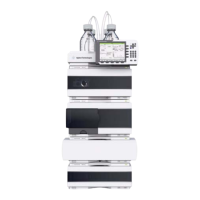128 Agilent 1260 Infinity DAD and MWD User Manual
6 How to optimize the Detector
Optimizing for Sensitivity, Selectivity, Linearity and Dispersion
Optimizing Spectral Acquisition (DAD only)
Storage of all spectra consumes a lot of disk space. It is very useful to have all
spectra available during optimization of a method or when analyzing unique
samples. However when running many samples of the same type, the large size
of data files with all spectra may become a burden. The detector provides
functions to reduce the amount of data, yet retaining the relevant spectral
information.
For spectra options see Table 25 on page 109.
Range
Only the wavelength range where the compounds in your sample absorb
contains information that is useful for purity checks and library searches.
Reducing the spectrum storage range saves disk space.
Step
Most substances have broad absorbance bands. Display of spectra, peak purity
and library search works best if a spectrum contains 5 to 10 data points per
width of the absorbance bands. For anisic acid (the example used before) a
step of 4 nm would be sufficient. However a step of 2 nm gives a more optimal
display of the spectrum.
Threshold
Sets the peak detector. Only spectra from peaks higher than threshold will be
stored when a peak-controlled storage mode is selected.
Margin for Negative Absorbance
The detector adjusts its gain during balance such that the baseline may drift
slightly negative (about -100 mAU). In some special case, for example, when
gradient with absorbing solvents are used, the baseline may drift to more
negative values.
Only for such cases, increase the margin for negative absorbance to avoid
overflow of the analog-to-digital converter.

